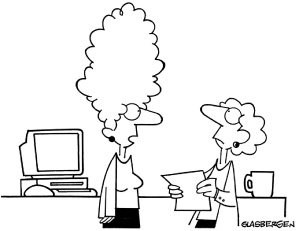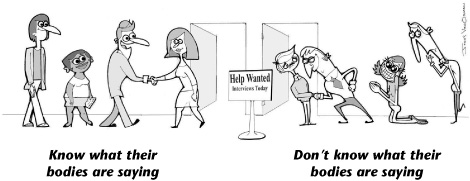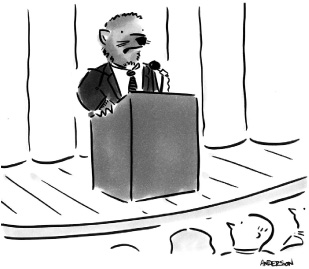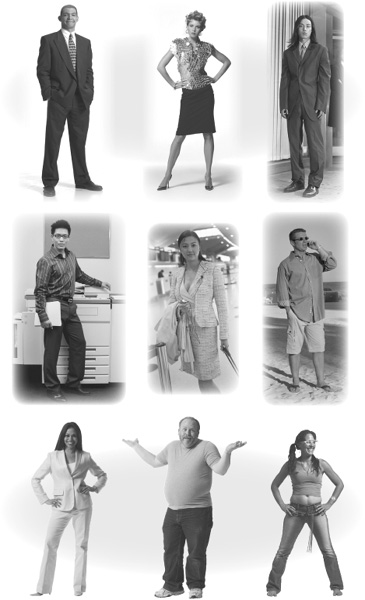CHAPTER 10
Selling Your Message without Saying a Word
I WAS TOLD THAT PAUL, the senior manager I had been asked to coach, was a poor communicator. After watching him at a leadership conference, I was in total agreement. It wasn’t what Paul said. His words were carefully chosen and well rehearsed. It was his nonverbal language. Mechanical in all his gestures, Paul’s body was screaming: “I’m uncomfortable and unconvinced about everything I’m telling you!”
Then there was the matter of timing. If a person’s gestures are produced before or as the words come out, he appears open and candid. If he speaks first and then gestures, however, as Paul did, it’s perceived as a contrived movement. And at that point, the validity of whatever is said comes under suspicion.
The question: Could I help?
The answer: Not much.
Oh sure, I could find ways to make Paul’s movements less wooden and his timing more fluid, but what he really needed was genuine passion!
I’ve learned a lot of things as a therapist, speaker, and coach. Most of all I’ve learned that the foundation of effective body language has to be honesty. If you don’t believe the message you’re delivering, if you don’t genuinely care about the people you’re trying to motivate or serve, or if you personally wouldn’t buy the product or service you are selling, at some point your body cues will leak the truth.
I wanted to tell you that story before going into this final chapter in which you’ll learn how to make your body language more positive and powerful. If you are trying to fool people into thinking you are sincere when you’re not, you’ll need a lot more than a few nonverbal tricks. But if you want to project your most authentic self—and use effective body language to help you do so—this chapter is full of the tips and techniques that will help you do just that! You’ll learn how to make a positive first impression in a matter of seconds. You’ll discover what body language signals to use to build strong relationships with clients and customers and coworkers. You’ll get tips on how to project confidence when making a business presentation.
It all starts with knowing how other people are translating your nonverbal messages.
Your Body Language as Others Read It
To change your body language, you must first be aware of what your body is saying. And this isn’t as easy as you may think. Take Sara, for example.
A vice president at a utility company, Sara complained that she was consistently overlooked for senior positions. “I don’t know what I’m doing wrong,” she told me. “I’m smart, enthusiastic, and hardworking. I can’t figure out why people don’t warm up to me.”
Well, maybe she couldn’t figure it out, but if you saw her in action, you’d know exactly what her problem was.
During my session with Sara, her eyes darted around the room as if searching for the nearest exit, her hands made choppy gestures, and she drummed her fingers on the conference table. I’d been with the woman for only an hour and already I was just as jumpy as she made all her business colleagues feel when dealing with her.
Sara perceived herself as projecting enthusiasm and energy, but the nonverbal cues she displayed were picked up as impatience and nervousness.
This is a common situation with body language. Often your nonverbal signals don’t convey what you intended them to. You may be slouching because you’re tired, but people read it as disinterest. You may be more comfortable standing with your arms folded across your chest (or you may be cold), but others see you as resistant and unapproachable. And keeping your hands stiffly by your side or stuck in your pockets can give the impression that you’re insecure—whether you are or not.
With nonverbal communication it’s not how the sender feels that matters most; it is how the observer perceives how the sender feels. And those interpretations are often made deep in the subconscious mind, based on a primitive emotional reaction that hasn’t changed much since humans first began interacting with one another.
TRY THIS When preparing for your next job interview, important meeting, or big presentation, rehearse in front of a video camera. Then view the video, staying as objective as possible. If you can hire a coach to help you, that’s even better. But if you will just keep in mind what you’ve learned in this book, you can successfully critique your own performance. Just remember to be kind to yourself. Clients are often stunned by their body language when they watch themselves for the first time. After viewing his recording of a mock job interview, an incredulous client exclaimed, “Hell, I wouldn’t hire me!” |
“May I offer a bit of constructive criticism? When you’re having lunch with a client, don’t carve little dollar signs in your mashed potatoes.”
Seven Seconds to Make a Positive First Impression
You’re at a conference and you turn to the stranger standing next to you. He turns to face you, and in that instant your brain makes a thousand computations. Is he someone to approach or to avoid? Should you flee or be friendly? Will he harm you or help you? After about seven seconds, you’ve already decided whether you like him. Sure, your opinion may change once you get to know the man better, but that first impression will always linger.
And, by the way, while you’re consciously and unconsciously evaluating him, he’s also making the same kind of instantaneous judgments about you.
In business first impressions are crucial. Once someone mentally labels you as likable or unlikable, everything else you do will be viewed through that filter. If someone likes you, she’ll look for the best in you. If she doesn’t like you or mistrusts you, she’ll suspect devious motives in all your actions.
Although you can’t stop people from making snap decisions—the human brain is hardwired in this way as a prehistoric survival mechanism—you can understand how to make those decisions work in your favor.
First impressions are more heavily influenced by nonverbal cues than by verbal cues. In fact, studies have found that nonverbal cues have more than four times the impact on the impression you make than anything you say. Luckily, the same nonverbal factors that draw you to certain people are what others are instinctively looking for in you.
We all want to interact and do business with people who are trustworthy and energizing, who put us at ease and make us feel good about ourselves. Luckily, these are the very qualities that you can project nonverbally in those first crucial seven seconds. Every encounter, from conferences to meetings to training sessions to business lunches, presents an opportunity to meet people, network, and expand your professional contacts by “managing your impression.”
Here are six powerful ways to make a positive first impression.
1. Adjust your attitude People pick up your attitude instantly. Before you turn to greet someone, enter an office for a business interview, or step on-stage to make a presentation, think about the situation and make a conscious choice about the attitude you want to embody. Attitudes that attract people include curious, friendly, happy, receptive, patient, approachable, welcoming, and helpful. Attitudes that are off-putting include angry, impatient, bored, arrogant, fearful, disheartened, and suspicious.
2. Smile A smile is an invitation, a sign of welcome. It says, “I’m friendly and approachable.”
3. Make eye contact Looking at someone’s eyes transmits energy and indicates interest and openness. To improve your eye contact, make a practice of noticing the eye color of everyone you meet.
4. Raise your eyebrows Open your eyes slightly more than normal to simulate the eyebrow flash that is the nonverbal signal of recognition and acknowledgment.
5. Shake hands This is the quickest way to establish rapport. It’s also the most effective. Research shows that it takes an average of three hours of continuous interaction to develop the same level of rapport that you can get with a single handshake.
6. Lean in slightly Leaning forward shows that you’re engaged and interested. But be respectful of the other person’s space. That means, in most business situations, staying about two feet away.
TRY THIS Once you’ve passed the seven-second test and are engaged in conversation with another person, you can create a lasting and positive impact by adding a single nonverbal component to a simple verbal statement. Here’s how to do it: When you meet someone and she tells you her name, find a way to repeat that name later in the conversation. And as you do, anchor the positive emotion (which your use of their name evokes) by touching the person lightly on the forearm. The impact of this brief touch comes from the fact that you have aroused positive feelings in an individual by remembering and using her name, and as you touch her arm, those positive emotions get linked (or anchored) to your touch. Then at subsequent meetings you can reactivate that initial favorable impression by once again lightly touching your acquaintance’s arm. |
Body Language through the Eyes of Your Customers
We’ve all experienced lousy customer service and the nonverbal signals that often accompany it. It’s the salesperson who’s on the phone— obviously on a personal call—and who continues the conversation while turning her back on you. It’s the receptionist who greets you with a disinterested and bored expression. It’s the human resource manager who rolls his eyes and sighs at your request for more information. Unfortunately, it’s an experience that happens all too often to all of us!

But this meant nothing to Ralph, a no-nonsense kind of businessman who had built his reputation and career on getting things done. Although he frequently gave presentations to key clients, Ralph had relied solely on his professional competence to win them over. Why should he be concerned about body language and customer relationships?
It was a good question, and I had to think for a bit before coming up with the following example.
Of all the professions that should be totally focused on the quality of the work done, the medical profession would rate high on most people’s lists. (Nobody wants an incompetent doctor!) And yet research on why patients sue doctors reveals that basic interpersonal skills (what is now referred to as clinical empathy) can be just as important as clinical skills in preventing lawsuits.
The most successful doctor/patient relationships are personal.
The most important factor in many potential legal cases, besides the injury itself, is the quality of the doctor/patient relationship. And a big part of that relationship depends on nonverbal communication. One study found that greater than 50 percent of 263 patients who sued their doctor claimed they were so turned off by the doctor that they wanted to sue him or her before the alleged event occurred!
The Ralph I referred to earlier was not a doctor. But if you are like Ralph and think that relationships with customers really don’t matter in your business, I’d ask you to reconsider. I don’t know of any profession—from healthcare to high tech—where customer relationships and body language are not a crucial part of business success.
Regardless of the industry you work in, there are some basic principles that apply to any profession. Look at the following research findings about the doctor/patient relationship and notice the similarities in your own line of work.
![]() Patients report greater satisfaction when doctors show nonverbal indicators of interest—such as leaning forward, nodding and gesturing more, establishing closer interpersonal distance, and spending less time looking at charts.
Patients report greater satisfaction when doctors show nonverbal indicators of interest—such as leaning forward, nodding and gesturing more, establishing closer interpersonal distance, and spending less time looking at charts.
![]() A crucial point in the doctor/patient encounter is the physician’s first greeting. Does the physician show personal concern by offering a handshake, maintaining eye contact, and giving a warm smile?
A crucial point in the doctor/patient encounter is the physician’s first greeting. Does the physician show personal concern by offering a handshake, maintaining eye contact, and giving a warm smile?
![]() Patients think they have spent more time with a doctor who sits down versus one who remains standing. That’s because a sitting position communicates interest and attentiveness to what the patient is saying, whereas a standing position may give the impression of control and an authoritative attitude.
Patients think they have spent more time with a doctor who sits down versus one who remains standing. That’s because a sitting position communicates interest and attentiveness to what the patient is saying, whereas a standing position may give the impression of control and an authoritative attitude.
![]() Doctors who look at their watches, drum their fingers, and look toward the door give the impression that they’re in a hurry or don’t have time for the patient.
Doctors who look at their watches, drum their fingers, and look toward the door give the impression that they’re in a hurry or don’t have time for the patient.
![]() If a doctor shies away from the patient, doesn’t lean toward the patient, or seems uncomfortable in the session, the body language communicates a problem that is sometimes not even stated.
If a doctor shies away from the patient, doesn’t lean toward the patient, or seems uncomfortable in the session, the body language communicates a problem that is sometimes not even stated.
![]() Poor body language in emotionally charged situations can lead to a breakdown in the doctor/patient relationship.
Poor body language in emotionally charged situations can lead to a breakdown in the doctor/patient relationship.
It’s also interesting to note that doctors who are competent with nonverbal communication have higher patient satisfaction scores. They are rated as more caring. And, whether you are a physician, salesperson, teacher, coach, negotiator, team leader, or senior manager, caring is a key component in your professional relationships. To quote Mark Twain, “People don’t care how much you know until they know how much you care.”
Who’s your customer? You may be in retail, where your customer walks into your shop. Or you may work in a large enterprise, where your customer is someone in another part of the organization. But wherever you are, it’s highly likely that part of your job involves customer satisfaction. And a big part of satisfying customers is the body language you use when dealing with them.
TRY THIS Think about what it’s like to be an internal or external customer of yours. How would you rate your personal level of service, courtesy, and respect? (You can also ask your customers to rate your service level.) Then think about the role that nonverbal signals play in how you are perceived. If you are sending mixed messages (for instance, saying, “I’d be delighted to help you” while your gestures and expression signal the opposite), all that wonderful verbiage means nothing. Customers believe that what your body says is the real message. |
Body Language On-stage
Whether you are speaking to a business audience of five hundred, pitching a product/service to potential buyers, or presenting your idea at a team meeting, you are “on-stage.” And whenever you are on-stage, nonverbal signals are key. People will be judging you by your appearance and your body language. And they’ll do it quickly. Often the audience will have come to a conclusion about you and your presentation before you’ve even had a chance to dazzle them with any of your content.
“Before I begin, let me apologize for my appearance; apparently there’s a full moon this evening.”
I don’t mean that your words don’t matter. Obviously, if you want people to be convinced, emotionally touched, or motivated to action, you will need to have relevant and meaningful content when you address them. But because body language sets up the initial perception, you’ll also need the following do’s and don’ts to gain the nonverbal advantage.
![]() Do get out and let the audience see your whole body.
Do get out and let the audience see your whole body.
![]() Don’t hide behind the lectern.
Don’t hide behind the lectern.
![]() Do stand centered on both feet (about shoulder width apart) with your knees slightly bent.
Do stand centered on both feet (about shoulder width apart) with your knees slightly bent.
![]() Don’t rock backward and forward or shift your weight from foot to foot. You will appear distracted or unsure of yourself.
Don’t rock backward and forward or shift your weight from foot to foot. You will appear distracted or unsure of yourself.
![]() Do open your body. Keep your shoulders back and your upper body relaxed. Always show your hands and use open-palm gestures.
Do open your body. Keep your shoulders back and your upper body relaxed. Always show your hands and use open-palm gestures.
![]() Don’t keep your arms too close to your body. Hands clasped behind your back make you look like you’re being arrested; hands clasped in front (the protective “fig leaf” position) make you look unsure of yourself.
Don’t keep your arms too close to your body. Hands clasped behind your back make you look like you’re being arrested; hands clasped in front (the protective “fig leaf” position) make you look unsure of yourself.
![]() Do take your time making eye contact. Look at individuals in the audience for at least three to five seconds to really connect.
Do take your time making eye contact. Look at individuals in the audience for at least three to five seconds to really connect.
![]() Don’t let your gaze sweep the audience too quickly or get stuck addressing only one part of the room.
Don’t let your gaze sweep the audience too quickly or get stuck addressing only one part of the room.
![]() Do move around. Human beings are drawn to movement. Our brains are programmed to pay attention to it.
Do move around. Human beings are drawn to movement. Our brains are programmed to pay attention to it.
![]() Don’t move constantly, however. You are most effective when you combine movement with physical pauses in which you stand absolutely still and highlight some key points.
Don’t move constantly, however. You are most effective when you combine movement with physical pauses in which you stand absolutely still and highlight some key points.
TRY THIS The next time you are preparing to give a presentation to any size audience, begin by defining your goal. For example, you might be trying to close a sale, get your boss to consider you for a promotion, or motivate your organization to embrace change. Whatever your objective is, use that as your framework for choosing supportive body language. If you want to project authority and control, disregard some of the rules you’ve just learned. Control and authority can be underscored by standing behind the lectern, minimizing your gestures, and making limited eye contact. But if projecting sincerity, caring, or concern is part of your message, you’ll get better results by keeping in mind the guidelines I’ve stated. |
The Silent Language of Leadership
Managers looking to help their organizations, their teams, or their departments thrive in the twenty-first century need to forget about issuing orders or coercing with threats. Success in today’s world takes employee engagement and creative collaboration—both of which must be freely given. You can’t force people to care or create or share their best ideas with others, but you can influence their behavior and motivate them to achieve great things.
To be a successful leader at any level of the organization, you need to tune in to the body language of those you lead so that you can understand the meaning behind what’s being said. That’s why all the nonverbal cues you’ve learned in this book will be extremely valuable. But you also need to be aware that nonverbally you are constantly expressing your feelings, your likes and dislikes, and your expectations. (All leaders express enthusiasm, warmth, and confidence—as well as arrogance, indifference, and displeasure through their facial expressions, gestures, touch, and use of space.)
When your nonverbal messages conflict with your verbal messages, the people you are talking to become confused. Mixed signals have a negative effect on performance and make it almost impossible to build relationships of trust. This is true whether you are the chief executive officer, a department head, a team leader, or a first-line supervisor.
Consider, for example, the oil company CEO who showed up at a refinery in an expensive suit and tie to discuss the firm’s state of affairs with rank-and-file operators, electricians, and members of the warehouse staff, who were dressed in their blue, fire-retardant overalls. That was just the beginning. After being introduced and walking to the front of the room, he removed his wristwatch (probably a Rolex) and quite visibly placed it on the lectern. The unspoken message: “I’m a very busy man, you can tell I don’t like coming into dirty places like this, and I have exactly twenty minutes to spend with you.” That message was quite different from the words he actually used to begin his comments: “I’m happy to be with you today.”
Which message do you think those refinery workers believed—the CEO’s spoken words or what his body language said?
The Body Language of Inclusion
No leader, regardless of how intelligent he or she may be, can succeed alone. Leaders need the support, energy, and ideas of others. In my research over the past twenty-five years, I’ve found that great leaders are great collaborators, able to make everyone feel like they are all part of the team. People work for bosses, but they work with leaders.

A great leader is one of the team.
At your next face-to-face meeting with a team member or colleague, remember that building inclusion has everything to do with your body language. If you incorporate the following positive nonverbal messages into your conversation, you will be sending signals of trust and respect.
|
The Body Language of Motivation
Pygmalion in the Classroom, one of the most controversial publications in the history of educational research, shows how a teacher’s expectations can motivate student achievement. This classic study gave prospective teachers a list of students who had been identified as high achievers. The teachers were told to expect remarkable results from these students, and at the end of the year the students did indeed make sharp increases on their IQ test scores.
In reality, these children had been chosen at random, not as a result of any testing. It was the teachers’ belief in their potential that was responsible for the extraordinary results. The children were never told they were high achievers, but this message was delivered subtly and nonverbally through expectancy behaviors such as facial expressions, gestures, touch, and spatial relationships.
TRY THIS Imagine that you found out that everyone on your staff had been identified as a high achiever. And imagine that this was a secret you couldn’t share with anyone on your staff—except through your body language. What nonverbal signals would you use to let people know they were special? More eye contact? Appreciative nods? Smiles? Once you get a good idea of what you would do, take one full week and nonverbally treat everyone who works for or with you as if they were potential stars. See if at least some of them don’t start living up to the high expectations your body language signals send. |
Dress for Success
My friend Joyce is an educator and an entrepreneur. One of the secrets of her success is the way she dresses. Even when traveling for a vacation, Joyce is in a business suit and heels. Her motto: “Wear great clothes. You never know whom you’ll meet!”
She may be onto something.
You can’t not communicate. Everything you do makes some kind of statement. The fact that Joyce wears a business suit and not jeans and a T-shirt sends a message.
The old saying “You can’t judge a book by its cover” may be true, but book-jacket and product-packaging designers around the world have built an industry betting that people do judge—and purchase—products based on how they look. And career counselors still advise clients to dress for the job they want, not the job they currently have. Counselors know that people are judged, at least to some degree, by their appearance—and they want their clients to gain a nonverbal advantage by already looking the part.
Which brings me back to you and your “personal packaging.” Office-appropriate attire has certainly changed over the years. Formal business suits aren’t a requirement in many workplaces, and the options available often lead to some questionable choices. As one management consultant told me: “In today’s world of business casual, it sometimes does seem like anything goes. To be fair, most of my clients’ employees display common sense when making their fashion statements, but I’ve also seen some less-than-subtle expressions of taste (or lack thereof), even in critical engagements.”

“Didn’t anyone tell you about casual Fridays?”
Clothes make a strong visual statement about how you see yourself. Comfort may aid productivity but, in this era of “Me, Inc.” and “the Brand Called You,” are flip-flops, sweats, jeans, and flashy or revealing clothing part of how you want to be judged? You might think you are expressing your individuality, but you could also be sending the message that you’re not a serious professional.
Clothing has an effect on both the wearer and the observer. It has been proven that people are more likely to give money (tips, charitable donations, and the like) or information to someone if that person is well dressed.
TRY THIS Experiment with your appearance. Notice how people react to you when you wear certain colors or styles. Then, based on those reactions and your career goals, you can make an informed decision about how you want to “package” yourself. |
Appropriate dress is a way of expressing respect for the situation and the people in it, so your look may change depending on the business circumstances.
Teresa is a management consultant—and a master at dressing for the role. She loves to wear hot pink, turquoise, and fire-engine red silk dresses with stiletto heels and lots of bling to work in her New York City office. But the moment she has to meet with a conservative client or one who is going through difficult times, Teresa transforms herself into a prim professional whose outfit matches the way she wants to be perceived. (In her words, “The success I dress for is that of my client.”) One member of her staff recalls meeting Teresa at the headquarters of a nonprofit religious organization, where they were to conduct focus groups. The staff member barely recognized her stylish boss. By dressing more like the client, Teresa fit right in. She looked like one of the nuns!
What message do you want to send?
The Body Language of Charisma
Max Weber, the father of sociology, first coined the term charisma to describe inspirational leaders. Originally from the Greek kharisma, meaning favor or divine gift, charisma has also been defined as “part confidence, part presence, and part sex appeal.” But however we define it, we know it when we see it. We call someone charismatic when they somehow compel us to embrace their vision—whether it’s corporate, social, religious, or political.
In the context of this chapter, I define charisma as body language that is completely congruent with the spoken word. Whether you are in management, sales, customer service, healthcare, or education, you are the most charismatic and convincing when what you are feeling internally is perfectly aligned with what you’re expressing.
I’m not the only expert to notice the connection between body language and charisma. Howard Friedman, a psychology professor at the University of California at Riverside, measures charisma by studying such nonverbal cues as facial expressions, gestures, and body movements. He finds that charismatic people smile naturally (with wrinkling around the eyes), use a variety of gestures, and touch others during conversations. Friedman has developed what he calls the Affective Communication Test, which some large U.S. corporations use to measure the charisma of potential leaders. And it seems to be valid. Toyota’s top U.S. salesman scored in the ninety-fifth percentile, and the sales manager of a leading hair replacement company scored in the ninety-ninth.
You Are “a Natural”
I once worked with the head of a research department who was preparing for a major presentation. One-on-one, this man was smart and charming and had a great sense of humor. His body language was congruent and expressive. But he was also an introvert. Put him on-stage in front of an audience and he became a nonverbal disaster. He didn’t need to work on technique so much as he needed to relax and let his natural personality and body language speak.
You may be in a similar situation. When talking with friends, you use your hands and face to help describe an event or object. You smile, frown, shrug your shoulders, and make broad sweeping gestures. Just remember that your business audience also relies on your nonverbal communication to understand the bigger, more inspiring picture.

Sometimes all you have to do to be truly impressive is to get out of your own way!
Standing Tall
In the U.S. population, about 14.5 percent of all men are 6 feet tall or taller. Among CEOs of Fortune 500 companies, that number is 58 percent. Even more strikingly, in the general American population 3.9 percent of adult men are 6 feet 2 inches or taller. Among the CEOs 30 percent are 6 feet 2 inches or taller. Somewhere in the American psyche, we have equated height with leadership ability.

“I read someplace that tall employees get better pay and faster promotions.”
Although it is unlikely that you will grow another 4 or 5 inches, you can appear taller and more authoritative by holding your body erect. Especially in formal speaking situations, how you stand is vital. Standing tall with an upright posture and your head held high is the body language of competence, confidence, and power.
The Body/Mind Connection
You already know that the way you feel affects your body language. If you are depressed, you tend to round your shoulders, slump, and look down. If you are upbeat, you tend to smile and hold yourself erect. But did you know that the reverse is also true? Your gestures, your movements, the way you hold and carry yourself, and even your facial expressions affect your emotions by sending messages back to your brain.
In several experiments individuals were asked to smile and were then shown pictures of various events. The smiling participants reported that the pictures pleased them and even made them feel elated. When asked to frown during the same kind of experiment, subjects reported feelings of annoyance and anger. Additional studies demonstrated not only that a smile is a consequence of feeling happy or content but also that putting on a smile can induce physiological changes in body temperature, heart rate, and skin resistance.
The best way to create a smile is to think of something or someone that genuinely amuses or delights you. But consider research findings that found that even if the smile were mechanically produced, positive feelings still emerged. This study had matched samples of people looking at Gary Larson cartoons. The first group ranked every cartoon as funnier than did the second group. The only difference is that members of the first group were asked to hold a pencil crosswise between their back teeth. The simulated smile caused by the pencil between their teeth affected their emotion—and their perception of the cartoons as funnier.
TRY THIS Let’s face it, confidence counts. A lot. I’ve seen many qualified people get passed over for promotion, lose a sale, or fail an interview simply because they couldn’t project a confident attitude. The next time you go into a situation in which you want to project your most confident self, you can start by standing up straight, pulling your shoulders back, and holding your head high. Just by assuming this physical position, you will begin to feel surer of yourself. And if you add a genuine smile (or even a pencil between your teeth), you will affect your brain and emotions even more positively! |
Putting It All Together
So you’re ready for your close-up—or at least an important presentation, a talk to a professional group, a job interview, or maybe just looking ahead to your day-to-day interactions with partners, peers, managers, team members, customers, and the people who report to you.
It’s likely, if it is some special presentation, that you’ve chosen just the right words, prepared just the right visuals, maybe even rehearsed what you are going to say. By now you’ve also gained some insight into all the nonverbal signals that are a key part of the message you’re sending—and why it’s so important to understand what your body is really communicating.

So there you have it—everything I’ve learned about nonverbal communication in the past twenty-five years as a therapist, coach, professional speaker, and seminar presenter. But I’m still leaning, still researching, and still making new discoveries. And everything I learn in the future (along with articles and other resources on this topic) will be posted to www.NonverbalAdvantage.com. I hope you will visit me there to learn more, ask questions, and share your success stories. I’m looking forward to hearing from you!




